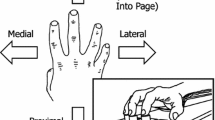Abstract
This study examined the effect of task goal on the structure of isometric force variability during precision grasping. In general, variability of isometric force production decreases when participants are asked to maintain a particular force output and are provided with visual feedback, although the irregularity of force output tends to increase under these conditions. In the current study we compared the tasks of holding an object using a precision grip and holding an object using a precision grip while matching a force target. Adults held an object between the index finger and thumb and force output was measured using load cells. The mass (92, 276, 460 g) and the grip aperture (5.5 and 8.5 cm) of the object were varied producing six different object conditions. The goal of the task was to either: (a) hold the object comfortably in a stable position (holding task) or (b) hold the object comfortably in a stable position while maintaining a constant target force level that matched the grip force of the holding condition (target task). The results showed that the amount of force variability in the target condition was lower than during the holding condition, while the force output was more regular in the holding condition. Increments in object mass increased force regularity in the holding condition whereas increments of force level decreased regularity in the target condition. The level of coherence between the two digits was very high (approximately 0.98) and maximum coherence occurred at a higher frequency during the target (0.94 Hz) as opposed to the holding (0.70 Hz) condition. The findings reveal that the goal of the task can qualitatively change the dynamical organization of the force output in prehension, even when the average force level produced is the same. This effect on the control strategy was mediated by visual information processes that interact with level of force output in determining the structure of variability. Theorizing about the organization of isometric force output should include the effects of task goals as well as the level of force per se.



Similar content being viewed by others
References
Cesari P, Newell KM (1999) The scaling of human grip configurations. J Exp Psychol Hum Percept Perform 25:927–935
Cesari P, Newell KM (2000) Body-scaled transitions in human grip configurations. J Exp Psychol Hum Percept Perform 26:1657–1668
Desmurget M, Grafton S (2000) Forward modeling allows feedback control for fast reaching movements. Trends Cogn Neurosci 1:423–431
Deutsch KM, Newell KM (2002) Children’s coordination of force output in a pinch grip task. Dev Psychobiol 41:253–264
Fitts PM (1954) The information capacity of the human motor system in controlling the amplitude of movement. J Exp Psychol 47:381–391
Flanagan JR, Burstedt MKO, Johansson RS (1999) Control of fingertip forces in multidigit manipulation. J Neurophysiol 81:1706–1717
Kroemer KHE (1975) Human force capabilities for operating aircraft controls at 1, 3 and 5 Gs. Tech Report. AMRL-TR-73–54. Wright-Patterson Air Force Base, Ohio
MacKenzie CL, Iberall T (1994) The grasping hand. North-Holland, Amsterdam
Miall RC, Weir DJ, Stein JF (1985) Visuo-motor tracking with delayed visual feedback. Neuroscience 16:511–520
Miall RC, Weir DJ, Stein JF (1993) Intermittency in human manual tracking tasks. J Mot Behav 25:53–63
Morrison S, Newell KM (1998) Interlimb coordination as a function of isometric force output. J Mot Behav 30:323–342
Napier JR (1956) The prehensile movements of the human hand. J Bone Joint Surg 38B:902–913
Newell KM (1986) Constraints on the development of coordination. In: Wade MG, Whiting HTA (eds) Motor development in children: aspects of coordination and control. Martinus Nijhoff, Boston, pp 232–256
Newell KM, McDonald PV (1994) Information, coordination modes and control in a prehensile force task. Hum Mov Sci 13:375–391
Newell KM, Slifkin AB (1998) The nature of movement variability. In: Piek (ed) Motor control and human skill: a multidisciplinary perspective. Human Kinetics, Champaign, pp 143–160
Newell KM, Broderick MP, Deutsch KM, Slifkin AB (2003) Task goals and change in dynamical degrees of freedom with motor learning. J Exp Psychol Hum Percept Perform 29:379–387
Pincus SM (1991) Approximate entropy as a measure of system complexity. Proc Natl Acad Sci U S A 88:2297–2301
Pincus SM, Goldberger AL (1994) Physiological time-series analysis: what does regularity quantify? Am J Physiol 266:H1643–H1656
Rearick MP, Slobounov SM (2000) Negative cortical D.C. shifts associated with coordination and control in a prehensile force task. Exp Brain Res 132:195–202
Rearick MP, Johnston JA, Slobounov SM (2001) Feedback-dependent modulation of isometric force control: an EEG study in visuomotor integration. Cogn Brain Res 12:117–130
Riley MA, Turvey MT (2002) Variability and determinism in motor behavior. J Mot Behav 34:99–125
Schanne FT (1972) Three dimensional hand force capability model for a seated person. Unpublished Ph.D. dissertation, University of Michigan, Ann Arbor, Michigan
Sharp WE, Newell KM (2000) Coordination of grip configurations as a function of force output. J Mot Behav 32:72–82
Slifkin AB, Newell KM (1999) Noise, information transmission, and force variability. J Exp Psychol Hum Percept Perform 25:837–851
Slifkin AB, Vaillancourt DE, Newell KM (2000) Intermittency in the control of continuous force production. J Neurophysiol 84:1708–1718
The MathWorks (1996) Signal processing toolbox user’s guide. Natick, MA
Vaillancourt DE, Slifkin AB, Newell KM (2002) Inter-digit individuation and force variability in precision grip of young, elderly, and Parkinson’s disease. Motor Control 6:113–128
Westling G, Johansson RS (1984) Factors influencing the force control during precision grip. Exp Brain Res 53:277–284
Acknowledgements
The authors would like to thank Todd Pataky and the anonymous reviewers for their helpful comments during the review process.
Author information
Authors and Affiliations
Corresponding author
Rights and permissions
About this article
Cite this article
Jordan, K., Newell, K.M. Task goal and grip force dynamics. Exp Brain Res 156, 451–457 (2004). https://doi.org/10.1007/s00221-003-1806-9
Received:
Accepted:
Published:
Issue Date:
DOI: https://doi.org/10.1007/s00221-003-1806-9




